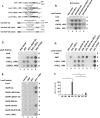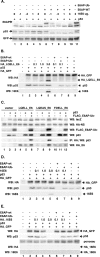Peptide interactions stabilize and restructure human papillomavirus type 16 E6 to interact with p53
- PMID: 22896608
- PMCID: PMC3457172
- DOI: 10.1128/JVI.01236-12
Peptide interactions stabilize and restructure human papillomavirus type 16 E6 to interact with p53
Abstract
Human papillomavirus type 16 (HPV-16) E6 (16E6) binds the E3 ubiquitin ligase E6AP and p53, thereby targeting degradation of p53 (M. Scheffner, B. A. Werness, J. M. Huibregtse, A. J. Levine, and P. M. Howley, Cell 63:1129-1136, 1990). Here we show that minimal 16E6-binding LXXLL peptides reshape 16E6 to confer p53 interaction and stabilize 16E6 in vivo but that degradation of p53 by 16E6 requires E6AP expression. These experiments establish a general mechanism for how papillomavirus E6 binding to LXXLL peptides reshapes E6 to then act as an adapter molecule.
Figures



References
-
- Brimer N, Lyons C, Wallberg AE, Vande Pol SB. 16 January 2012. Cutaneous papillomavirus E6 oncoproteins associate with MAML1 to repress transactivation and Notch signaling. Oncogene. doi:10.1038/onc.2011.589 - DOI - PMC - PubMed
-
- Charbonnier S, Zanier K, Masson M, Trave G. 2006. Capturing protein-protein complexes at equilibrium: the holdup comparative chromatographic retention assay. Protein Expr. Purif. 50:89–101 - PubMed
-
- Chen JJ, Hong Y, Rustamzadeh E, Baleja JD, Androphy EJ. 1998. Identification of an alpha helical motif sufficient for association with papillomavirus E6. J. Biol. Chem. 273:13537–13544 - PubMed
-
- Cooper B, et al. 2003. Requirement of E6AP and the features of human papillomavirus E6 necessary to support degradation of p53. Virology 306:87–99 - PubMed
Publication types
MeSH terms
Substances
Grants and funding
LinkOut - more resources
Full Text Sources
Other Literature Sources
Research Materials
Miscellaneous

